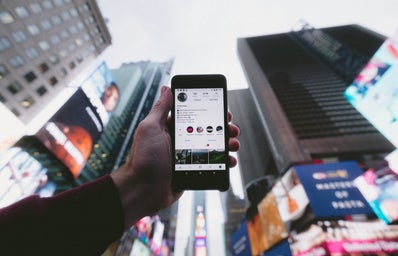Ever heard this saying: “If you’re not paying for the product, then you are the product”?
In the age of the fourth industrial revolution, not hopping on the social media bandwagon seems impossible or you’re bracing yourself to be labeled a hermit. As the majority, have you ever wondered about its effects on you? For starters, look around. People are glued to their devices, like a moth to a flame. Is this behavior a conscious choice, or one that’s been rewired as our autopilot to cope with boredom, loneliness, stress etc? Furthermore, are users aware that their behaviors are being programmed and profited off by these platforms? Instead of confronting these questions, we only hear concerns about our privacy being compromised and data sold. However, there’s more to the aforementioned than meets the eye.
We need to first understand that users are now the product being marketed. The technology industry today has slipped from one fundamentally created for good; bringing people together from all over the world etc, to specializing in selling its users’ attention and behavior. They’ve become masters in hijacking human psychological vulnerabilities, predetermining users’ behaviors through persuasive technology while eroding the social fabric.
“This is exactly what product designers do to your mind. They play your psychological vulnerabilities (consciously and unconsciously) against you in the race to grab your attention.” – Tristan Harris, former design ethicist at Google
Let’s peel back the onion by stating the obvious; tech giants have harvested unimaginable amounts of data through tracking our every move. Artificial intelligence mechanisms then eat up this information, analyzing and predicting types of content to keep you hooked, kinds of emotions that tend to trigger you amongst others. With built-in self improvement algorithms, it takes on a life of its own; driving accuracy of predictions and overpowering the human consciousness, or so it seems. These large amounts of data collected acts as the foundation enabling persuasive technology.
Next, we’ll dive into persuasive technology – a model aimed at exploiting human psychological vulnerabilities, and programming the adoption of social media as a default in curing boredom etc. Under this model, multiple techniques are being deployed. Let’s zero in on five common ones below.
Intermittent variable rewards– linking of a user’s action with a variable reward is one of the many tactics. This spawns the compulsive checking, refreshing of social feeds to see replenished content as adopted by email etc. Being the same “drug” planted in slot machines, it’s no surprise that this tactic takes the cake for encouraging addiction.
Infinite curated feedsserve as your own “Truman show” and personal digital pacifier, along with the ubiquitous autoplay function whose goals are to extract as much of your attention as possible.
Exploiting our psychological needs for reciprocationthrough likes, follows and endorsements, enables social reciprocity factories like Linkedin to achieve great success.
Instant interruption tacticssuch as read receipts, typing status adopted by WhatsApp, not only heightens our urgency to respond but also elicits a higher response rate than asynchronous ones.
FOMO– the entirety of social media builds upon this vulnerability that needs no introduction. We are genetically programmed to “FOMO” due to fear of being excluded or ostracized, dating back to ancient times where our brains register “missing out” as a social threat to survival. Keeping up with social events and gossip makes one feel connected and included. Psychologically, experiencing “FOMO” agitates our nervous system and logging on social media provides that instant relief and “connection”. This behavior is further perpetuated by dopamine hits released from social validation feedback loops, leaving people craving for more.
With these tactics adopted as the Silicon Valley standard playbook, users unknowingly find themselves concerned with what others are doing. Posts showing exciting lives; hand-picked to elevate one’s online identity and brand, misconstrues idealized states of nature for many atop creating a false sense of connection. Users’ attention span has downgraded due to bombardment of content, and sense of self are conflated with the truth amidst others. This points to a dangerous misalignment of incentives between users and platforms. Human innate goals for connection do not reconcile with those of the corporates, who follow the religion of profit at all costs.
Lastly, by compounding heaps of users’ data with persuasive technology tools, tech companies could easily manipulate how we use our time, gradually modifying our behavior in a predetermined way. Ever found yourself spending more time than planned on social media, perhaps looking at content that wasn’t in your original timeline? That’s one example of the AI manipulating your consciousness. Tech giants’ power to predetermine human behaviors with high certainty would mean high success for advertisers, their true and sole customers.
Looking at the intentions and backbone of this industry is frankly disturbing, heartbreaking even. Humanity has been reduced to nothing but a mode. In recent years, we see silicon valley pioneers like Chamath Palihapitiya and Sean Parker, former VP of growth and the first president of Facebook respectively speaking out, warning on the gravity of the social media phenomena and fighting for more ethical practices. On the side of current leadership, we see for one, Zuckerberg’s controversial responses time and time again, making us wonder if reformations on silicon valley’s business model would ever occur.
Instead of waiting for protection laws and regulation to keep up or technology giants to reform their business model, users could perhaps begin to regain control over their behaviors with awareness. Despite claims of progenitor social media platforms “dying out” in 2022, history will only repeat itself with new platforms like Tiktok emerging as replacements (remember Myspace?), influencing our lives for years to come. With that said, as an active user seduced by the offerings of social media, I believe in adopting the “awareness is key” approach coupled with discernment, striking a balance to take the positives and leave the bad.


